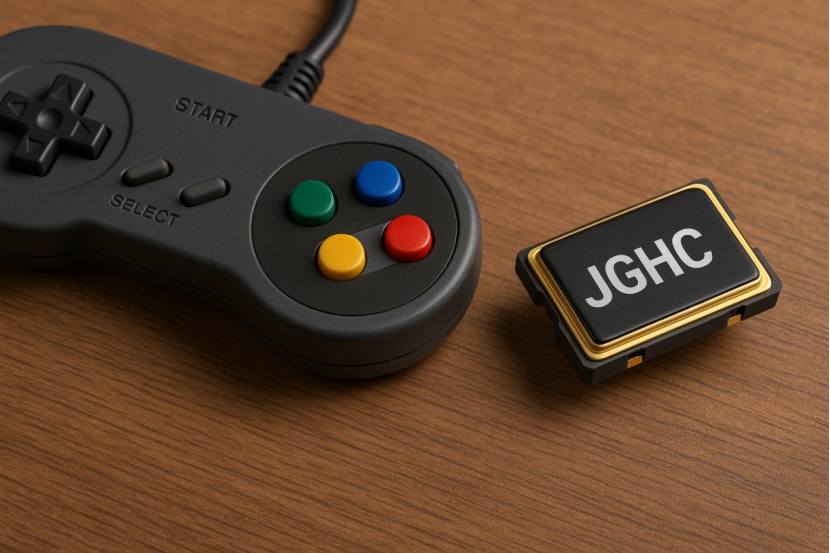What is the Oscillator of a CPU?
Apr 23, 2025
In the world of modern gaming, every frame of animation, every sound effect, and every input from your controller is governed by intricate timing and synchronization. Behind the scenes of every high-performance gaming console, there’s a hidden hero ensuring that everything works in harmony: the crystal oscillator. This small but mighty component plays a critical role in the clock synchronization of CPUs, GPUs, and audio processors, making it indispensable for a seamless gaming experience.
The Role of Crystal Oscillators in CPU and GPU Timing
At the heart of every CPU (Central Processing Unit) and GPU (Graphics Processing Unit) is a need for precise timing. Whether it’s rendering high-resolution graphics or executing complex AI routines, each operation within the processor is reliant on an accurate clock signal. This is where the crystal oscillator comes into play.
A crystal oscillator is a component that generates a stable frequency signal using the mechanical vibrations of a quartz crystal. The crystal's natural resonance is leveraged to produce a frequency that can be counted and used to synchronize operations across various processing units within the console. In gaming consoles, the crystal oscillator acts as the timekeeper, ensuring that the CPU, GPU, and other components are operating in sync.
The CPU clock governs the basic functions of the processor, dictating how quickly it can execute instructions. A faster clock cycle means that the CPU can perform more calculations per second, translating to improved overall performance. In modern gaming, this speed is crucial for maintaining smooth gameplay and minimizing lag.
Similarly, the GPU relies on clock signals to manage the rendering of high-quality graphics, especially in graphically intensive games. Without a precise and stable clock signal, the GPU could struggle to output frames consistently, leading to stuttering or tearing in the visuals, which can disrupt the immersive experience.
Impact of Stable Clock Signals on Graphics Rendering
The synchronization of the clock signals from the crystal oscillator is fundamental for achieving high-quality graphics rendering in real-time. As gamers demand more detailed and complex environments, the GPU is under constant pressure to render a large number of frames per second (FPS). This process requires coordination between multiple elements, including texture mapping, shading, and frame buffering.
The crystal oscillator ensures that the timing of each pixel being rendered aligns perfectly with the system’s display output, allowing for smooth transitions between frames. A stable clock signal allows the GPU to consistently push frames to the display without hiccups. If the timing between frames is off, it could result in visual stutter, ghosting, or a phenomenon known as "screen tearing," where two frames are shown at once, distorting the image.
In high-performance gaming systems, especially when dealing with 4K or 8K resolutions, the need for precise synchronization becomes even more critical. Without the precision provided by crystal oscillators, the GPU would fail to maintain the necessary timing, resulting in a subpar gaming experience.
The Role of Crystal Oscillators in Audio Synchronization
Gaming isn't just about the visuals—sound plays a crucial role in immersing players in virtual worlds. Crystal oscillators are equally important for audio processors, ensuring that sound effects, music, and voiceovers are in perfect sync with the on-screen action.
Every audio signal in a game, whether it’s background music or sound effects, needs to be sampled and played back at a consistent rate. This rate, known as the sample rate, determines the quality of sound playback. For audio processors to deliver a clear, uninterrupted sound experience, they must receive a steady clock signal from the oscillator. Without it, players could experience audio glitches such as desynchronized sound effects, lagging dialogue, or poor-quality sound reproduction.
The stability of the oscillator ensures that audio processors maintain a consistent timing signal, which is essential for delivering high-fidelity sound that complements the gaming experience. Whether it’s the sharp crack of a weapon firing, the rumble of footsteps on different surfaces, or the ambient sounds that build atmosphere, a steady clock signal keeps everything aligned.
The Impact on Data Transmission and System Efficiency
Beyond graphics and audio, crystal oscillators are also crucial for synchronizing data transmission between different components of the gaming console. The communication between the CPU, GPU, memory, and peripheral devices such as controllers or storage drives requires high-speed data exchanges.
For instance, when loading a new level or when a player initiates an action, there’s a massive amount of data that needs to be transferred quickly and efficiently. The crystal oscillator ensures that all data channels operate at the correct frequency, preventing bottlenecks or delays. It effectively acts as the master clock that keeps all these systems in check, enabling smooth data transfers and reducing the chances of lag during gaming sessions.
Moreover, having a stable clock signal improves overall system efficiency by minimizing errors in data transmission. If components operate at slightly different frequencies, it can result in data loss or transmission errors, leading to system crashes or glitches.
The Significance of Crystal Oscillators in Gaming Performance
Crystal oscillators are more than just tiny chips that sit inside gaming consoles. They are integral to the overall performance, making them a crucial piece of hardware in the gaming ecosystem. Their ability to provide stable clock signals impacts every aspect of a gaming console, from CPU and GPU performance to audio synchronization and efficient data transmission.
In particular, as gaming technology advances, the demand for higher frame rates, more detailed textures, and richer soundscapes continues to rise. Without the precision of crystal oscillators, it would be nearly impossible to achieve these demanding specifications. This is why high-end gaming consoles invest in high-quality crystal oscillators to provide the best experience for gamers.
Crystal oscillators are far more than just a technical component within a CPU or GPU; they are the unseen force that ensures your gaming experience is seamless and immersive. Their ability to synchronize the clock signals of various components—from graphics rendering to audio playback—ensures that your game runs smoothly, with high-quality visuals and sound.
Whether you are playing an action-packed shooter, a strategy game, or a role-playing game, the stability provided by these oscillators enhances the overall experience, delivering the fluidity and precision that every gamer craves. So the next time you fire up your favorite game, remember the quiet hero working tirelessly behind the scenes: the crystal oscillator.
Read More


